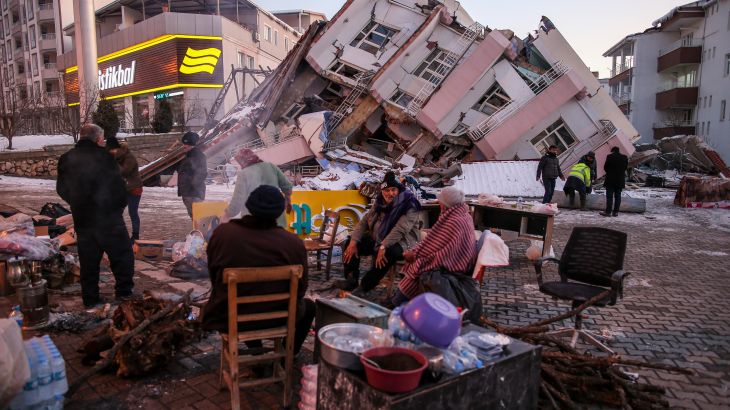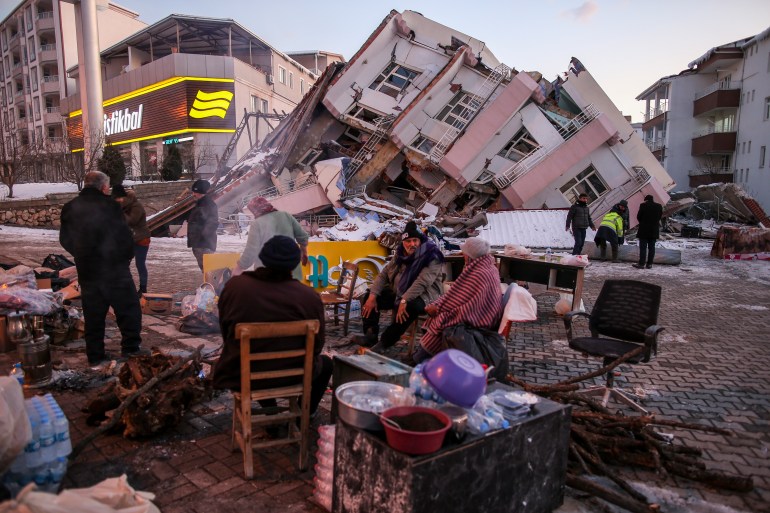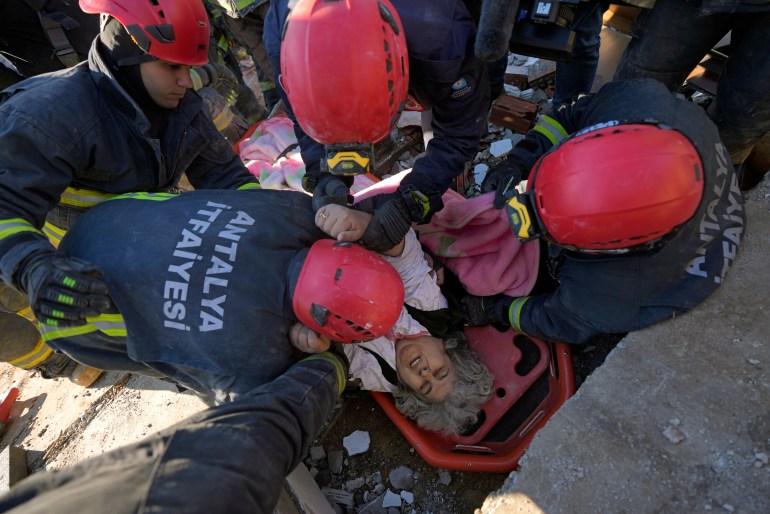Why did so many buildings collapse in Turkey?
A combination of factors led to the widespread destruction that has left thousands still trapped under debris.

“We are searching for my niece, Rukiye,” a tired-looking man with bloodshot eyes told local reporters as he peered through the twisted remains of a hospital in the southern Turkish province of Hatay on Wednesday.
“She is 23, a nurse. She entered the hospital hours after the first earthquake to help evacuate patients. The building collapsed on her when the second earthquake hit. She saved so many, but couldn’t get out herself. We know she was alive for at least 16 hours – she called her husband from under the rubble. But now the rescuers say she is likely gone.”
Keep reading
list of 4 itemsEarthquake fever grips Turkey’s Istanbul amid fears of ‘the big one’
Paint and tears: Northwest Syria commemorates 2023 earthquakes
‘She was the one’: Finding love in the midst of Turkey’s earthquake
Thousands of people like Rukiye are believed to still be stuck in the debris of collapsed buildings across Turkey’s southeast following Monday’s devastating earthquakes. According to the government, two major tremors and hundreds of aftershocks destroyed at least 6,444 buildings across 10 provinces, killing more than 12,800 people as of Thursday afternoon.
A tragic combination
As rescuers continue to search through the rubble looking for miracles, the nation is now trying to understand why this natural disaster – for which Turkey was supposedly preparing for more than 20 years – caused so much damage to the country’s infrastructure.
Was it that the two earthquakes – the first at a magnitude of 7.8 and the second at 7.6 – were simply too violent for most buildings to survive? Or that the buildings were not up to modern construction standards? Was there negligence on the part of the authorities?

According to Professor Okan Tuysuz, a geological engineer from Istanbul Technical University, a tragic combination of all of the above led to Monday’s catastrophe.
“We are dealing with truly massive earthquakes here,” Tuysuz told Al Jazeera. “The first one was roughly equivalent to the energy release from an explosion of about 5 million tonnes of TNT. The second was equivalent to 3.5 million tonnes. Most buildings would struggle to withstand such force.”
Sinan Turkkan, civil engineer and president of Turkey’s Earthquake Retrofit Association, agreed. “Not only were the earthquakes extremely forceful, but they also hit in quick succession,” he explained. “Many buildings only received light to medium damage in the first quake but collapsed after the second one.”
While factoring in that tremors at these magnitudes in quick succession would pose a risk to any building, experts underlined that a tragedy on this scale was not in any way inevitable.
“According to official estimates, 6,000 to 7,000 buildings collapsed on Monday. However strong, no earthquake could have caused this much damage if all buildings were up to standard,” Turkkan said.
On Wednesday, Turkey’s President Recep Tayyip Erdogan defended his government’s preparations for and response to the earthquakes during a visit to the disaster zone, saying it was “impossible for anyone to prepare for the scale of the disaster”.
He then went on to say that the state will rebuild all collapsed buildings in all 10 provinces affected by the earthquake within a year.
“Just like we did in Malatya, Elazig, Bingol, Van [we will rebuild here]. This is a business we know well. Our government proved its ability [to rebuild] time and time again in the past. We will achieve the same in Hatay, in Maras and also in eight other affected provinces”.
Most of the buildings that collapsed on Monday were constructed before 1999, when a magnitude 7.6 earthquake hit the Western Marmara region, killing 17,500 people. Since then, the government improved the Turkish seismic design code significantly and in 2008, embarked on an ambitious urban transformation project to prepare Turkey for the next big earthquake.
Code enforcement
In November 2022, after a magnitude 6 earthquake damaged more than 2,000 buildings in Duzce, northern Turkey, environment and urbanisation minister Murat Kurum underlined that the authorities were working towards making every building in the country “earthquake safe by 2035”.
“We already rebuilt 3.2 million residences,” Kurum said in a social media post. “250,000 residences across 81 provinces and 992 districts are currently being transformed [to meet current regulations]. 6.6 million houses and businesses have been audited. 24 million of our citizens are currently living in earthquake-safe abodes.”
These ambitious efforts, however, were not able to prevent the disaster.
“On paper, Turkey’s seismic design code is up to global standards – it is actually better than most,” Turkkan said. “In practice, however, the situation is very different.”

The government offered financial incentives but did not make participation in its urban transformation project compulsory. This effectively meant only people who were in a position to make money from rebuilding – people in possession of valuable plots suitable for further development – agreed to demolish their old properties and rebuild according to the latest code. Many did not want to spend money on rebuilding work or reinforcements that did not seem urgent. This is why, experts say, more than 20 years after the Marmara earthquake, Turkey is full of buildings constructed using sub-par materials and long-discredited construction techniques that immediately crumble when faced with a strong tremor.
“This saddens me deeply as an engineer,” Turkkan said. “If we managed to get everyone on board, we could have either reinforced or rebuilt all defective buildings in the past 20 years. We could have saved at least 5,000 of the buildings that we lost on Monday from complete destruction. We could have saved many, many lives.”
Experts believe the government and local authorities could have taken further precautions to ensure all buildings were safe and earthquake design regulations are being implemented in all contexts.
“For years we held conferences, wrote reports and sent them to local authorities. We told them big earthquakes will inevitably hit cities like Hatay and Gaziantep again,” Tuysuz said. “We explained to them however strong, no building built directly on a fault line can survive an earthquake – it would be torn apart. We said we should create accurate fault-line maps for the entire country and transform areas directly on active fault lines into green zones with construction bans. No one listened.”
Even new buildings were lacking
There were also shortcomings in ensuring regulations were being followed in new construction.
“Some relatively new buildings also collapsed in this earthquake, which likely means contractors took shortcuts, tried to economise using sub-par materials and authorities failed to do their due diligence before approving construction projects,” Tuysuz said.
Several schools, administrative buildings, hospitals and even the headquarters of Turkey’s Disaster and Emergency Management Authority (AFAD) in Hatay also collapsed on Monday.
“According to the state’s own regulations, public buildings are supposed to be much stronger than private ones,” Turkkan explained. “When you are building a hospital, a post office or any other public building, you are instructed to use more concrete, more iron, get more detailed ground studies. This is to ensure those buildings survive any earthquake or other natural disaster and so that they can continue serving people at a time of crisis”.
Tuysuz agreed. “It is completely unacceptable for a public building, a power plant or an airport to collapse in an earthquake,” he said. “There are very strict regulations in place to prevent this. The scenes we are witnessing today in the southeast are proof of the state’s shortcomings in implementing its own rules even in constructions over which it has complete control.”
So what needs to be done?
There are some 20 million buildings in Turkey. In Istanbul, where experts believe a major earthquake will hit sooner or later, there are 1.2 million, according to the Kandilli Observatory and Earthquake Research Institute at Bogazici University. Their experts believe a significant percentage of these buildings are not in a condition to withstand tremors at high magnitudes.
Reinforcing or rebuilding all at-risk buildings in all earthquake-prone areas would be technically and logistically difficult and costly. Yet it is a task that cannot be avoided or delayed.
“The government needs to be more forceful in making people get their buildings audited, reinforced and if necessary rebuilt,” Turkkan said. “People are understandably not volunteering to pay up, but this is a matter of life and death, and it should be treated as such.